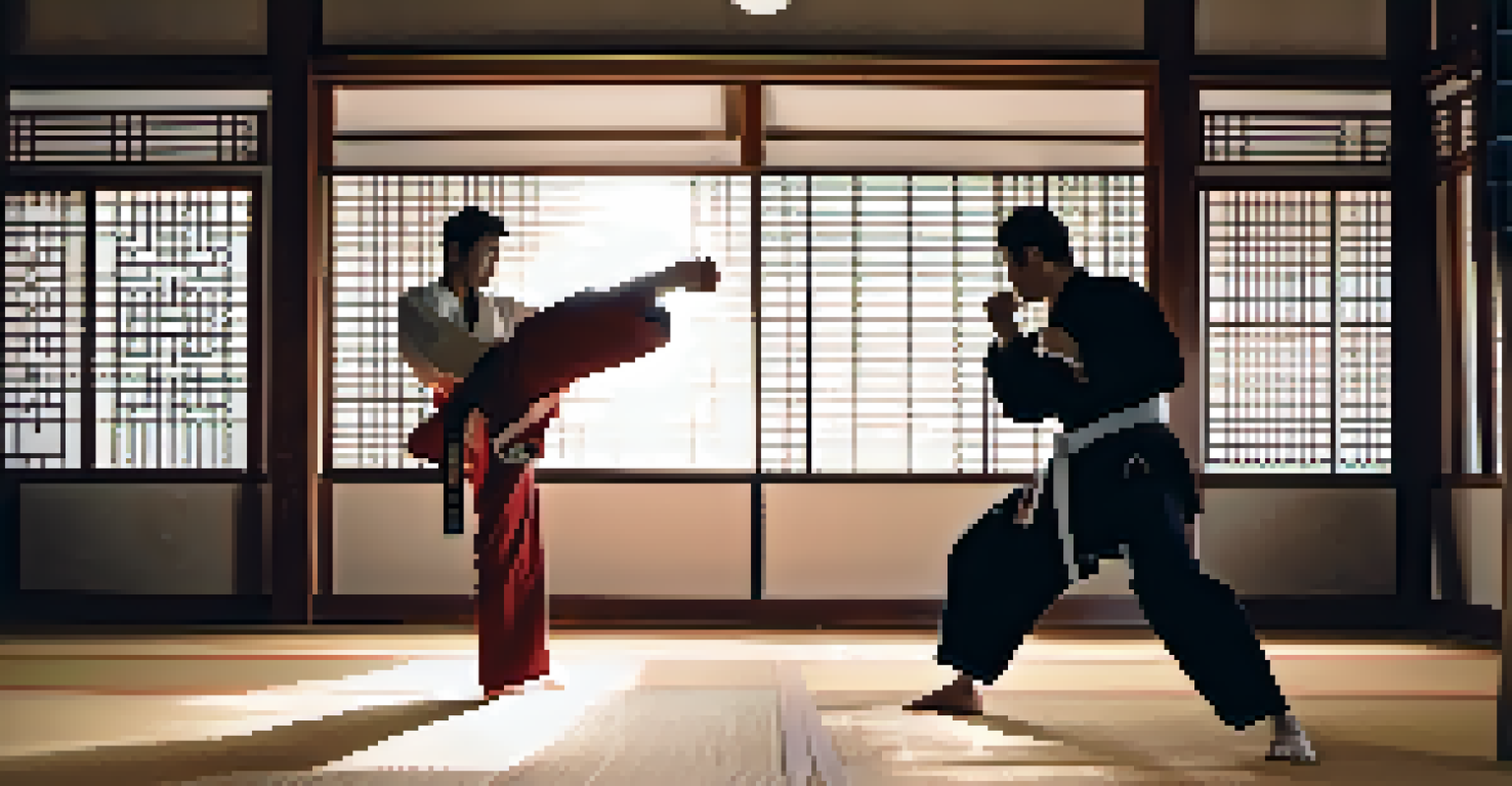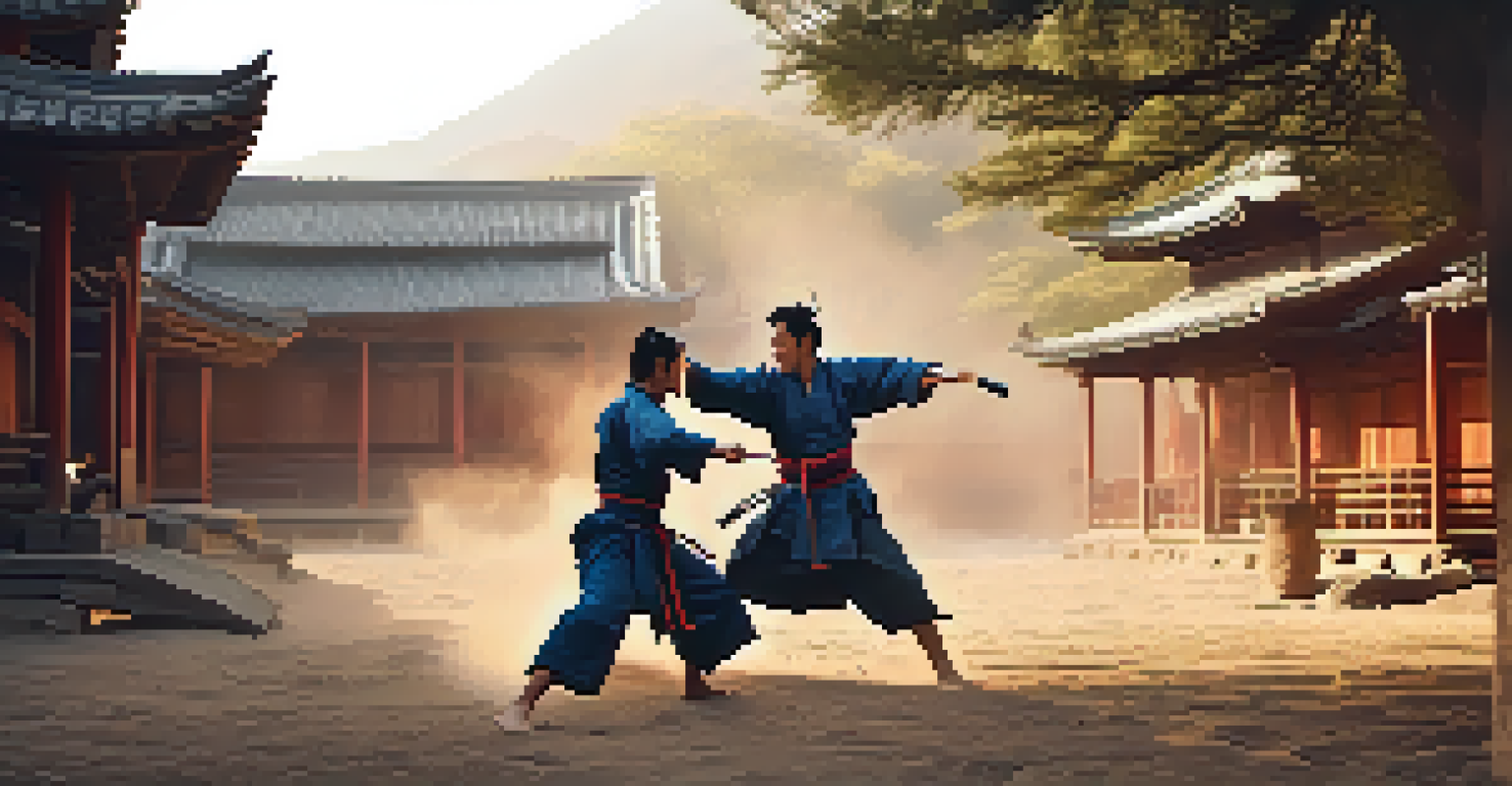The Role of Martial Arts in Portraying Historical Accuracy

Understanding Martial Arts as Historical Narratives
Martial arts have a rich history that often intertwines with cultural narratives. Each style, from Karate to Kung Fu, has roots in specific historical contexts, reflecting the values and philosophies of the time. These practices serve not just as combat techniques but as storytelling tools that preserve heritage.
Martial arts are not just about fighting; they are about the stories behind the techniques and the culture they represent.
For instance, the origins of Brazilian Jiu-Jitsu can be traced back to Japanese Jujutsu, showcasing how martial arts evolve and adapt through cultural exchanges. This evolution is often portrayed in films, where martial arts serve as a window into historical events or societal changes. Understanding these narratives helps audiences appreciate the deeper significance behind each move and technique.
Moreover, when filmmakers incorporate authentic martial arts into their storytelling, they enhance the credibility of the historical setting. This authenticity provides viewers a richer experience, allowing them to connect with the characters and their journeys on a deeper level.
The Importance of Accuracy in Martial Arts Depictions
Accuracy in portraying martial arts is crucial for maintaining historical integrity. When filmmakers take creative liberties, they risk misrepresenting the culture and history behind these practices. For instance, a film that inaccurately depicts a traditional martial art can perpetuate stereotypes and misunderstandings, impacting public perception.

Consider the portrayal of Samurai in films; when done accurately, it captures not only the martial prowess but also the ethical dilemmas and societal roles they held. This level of detail enriches the narrative, allowing audiences to grasp the full complexity of historical warriors. It fosters a deeper respect for the martial arts and their cultural significance.
Martial Arts as Cultural Narratives
Martial arts reflect historical contexts and cultural values, serving as both combat techniques and storytelling tools.
This commitment to accuracy also resonates with martial artists who appreciate seeing their craft represented genuinely. It cultivates a sense of pride and connection to their heritage, encouraging the next generation to engage with their culture's history.
Cinematic Techniques for Authentic Martial Arts Portrayal
Cinematography plays a pivotal role in how martial arts are presented on screen. Techniques such as slow motion, close-ups, and dynamic camera angles can highlight the intricacies of martial arts movements, making them visually captivating. These techniques not only enhance the action but also emphasize the historical context behind each fight.
The best way to understand a culture is through its martial arts, as they reflect the history, philosophy, and struggles of the people.
For example, the use of traditional settings and costumes in films can transport viewers back in time, immersing them in the era being depicted. This visual authenticity helps reinforce the martial arts being portrayed, as viewers can see how they fit into historical practices and social structures. The attention to detail in these aspects is what sets apart a good film from a great one.
Additionally, sound design plays a crucial role in martial arts scenes. The impact of each strike and the rhythm of movements can create a visceral experience that resonates with audiences, further grounding the portrayal in reality and history.
Cultural Representation and Martial Arts in Film
Film serves as a powerful medium for cultural representation, particularly in the portrayal of martial arts. Each martial art embodies unique philosophies and cultural practices, making it essential for filmmakers to approach these subjects with respect and authenticity. This representation shapes how cultures are perceived globally.
For instance, films that showcase the beauty and discipline of Tai Chi not only entertain but educate viewers about its historical significance and the values it promotes, such as harmony and balance. This cultural lens enriches the audience's understanding and appreciation of the martial art, setting a standard for ethical storytelling.
Importance of Historical Accuracy
Accurate portrayals of martial arts in film help maintain cultural integrity and foster respect for their historical significance.
Moreover, accurate cultural representation helps combat stereotypes and fosters a more nuanced view of the martial arts community. It encourages audiences to engage with the culture behind the art, promoting a sense of global connectedness and understanding.
The Role of Experts in Ensuring Historical Accuracy
Incorporating martial arts experts in film production is vital for ensuring historical accuracy. These experts provide invaluable insights into techniques, training methods, and the cultural context of the martial arts being portrayed. Their expertise can significantly enhance the authenticity of fight scenes and character development.
For example, having a martial arts choreographer involved in a film can lead to more realistic and respectful portrayals. They can guide actors in understanding not only the physical aspects of martial arts but also the mental and emotional components that define these practices. This depth adds layers to characters, making their martial arts journeys more relatable and engaging.
Furthermore, these collaborations can lead to educational opportunities for filmmakers and audiences alike. By bridging the gap between art and authentic practice, experts help create a richer narrative that honors the history and significance of martial arts.
Challenges in Portraying Martial Arts Historically
Despite the benefits, there are challenges in accurately portraying martial arts in historical contexts. Filmmakers often face the dilemma of balancing entertainment with authenticity. While action-packed sequences may attract audiences, they can sometimes overshadow the importance of historical accuracy, leading to misrepresentation.
Moreover, the globalization of martial arts has created a melting pot of styles and interpretations, making it difficult to present a singular narrative. This can lead to oversimplification or distortion of the martial arts' origins and significance, which can confuse viewers about its cultural roots.
Social Contexts Shape Martial Arts
Martial arts often emerge from social and political contexts, enriching film narratives with deeper character motivations and cultural identity.
Navigating these challenges requires careful research and a commitment to authenticity. By prioritizing historical accuracy, filmmakers can create impactful narratives that respect the traditions and stories behind martial arts, while still engaging modern audiences.
Martial Arts as a Reflection of Social and Political Contexts
Martial arts often serve as a reflection of the social and political contexts in which they developed. For instance, many styles emerged in response to societal needs, such as self-defense or national identity. This historical backdrop can enrich storytelling in film, providing deeper layers to characters and their motivations.
Consider the portrayal of Kung Fu in films during the 1970s; it was not just about the fighting; it symbolized resistance and empowerment for marginalized communities. This connection to social issues makes martial arts a compelling narrative tool that resonates with audiences on multiple levels.

By acknowledging these historical contexts, filmmakers can create more meaningful stories that highlight the struggles and triumphs of individuals within their societies. This approach fosters a greater appreciation for martial arts as more than just physical combat, but as a vital part of cultural identity and history.